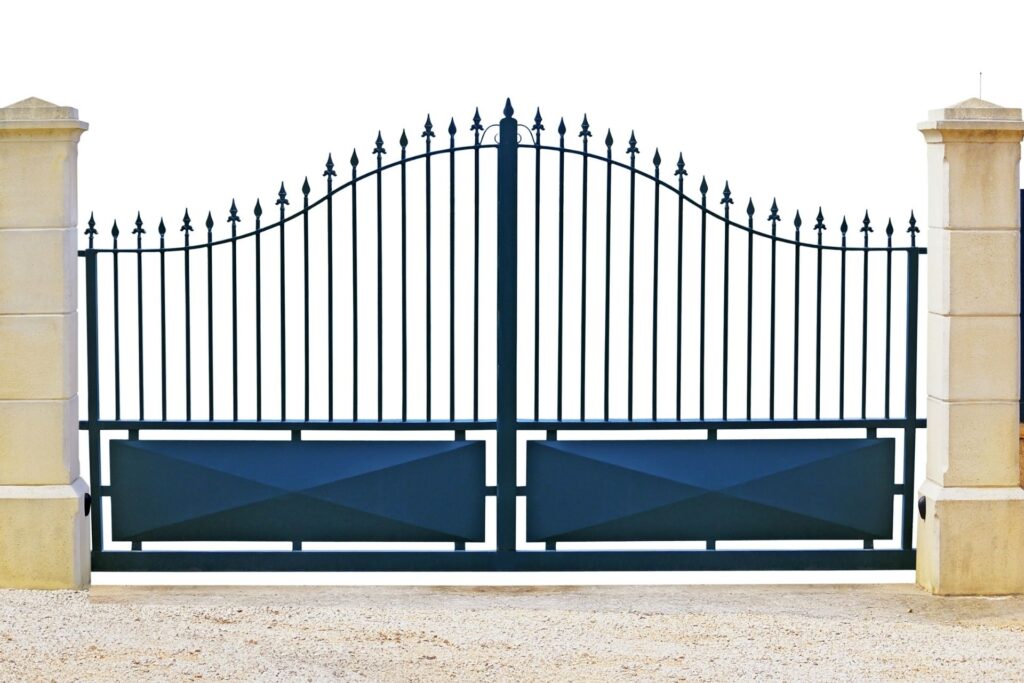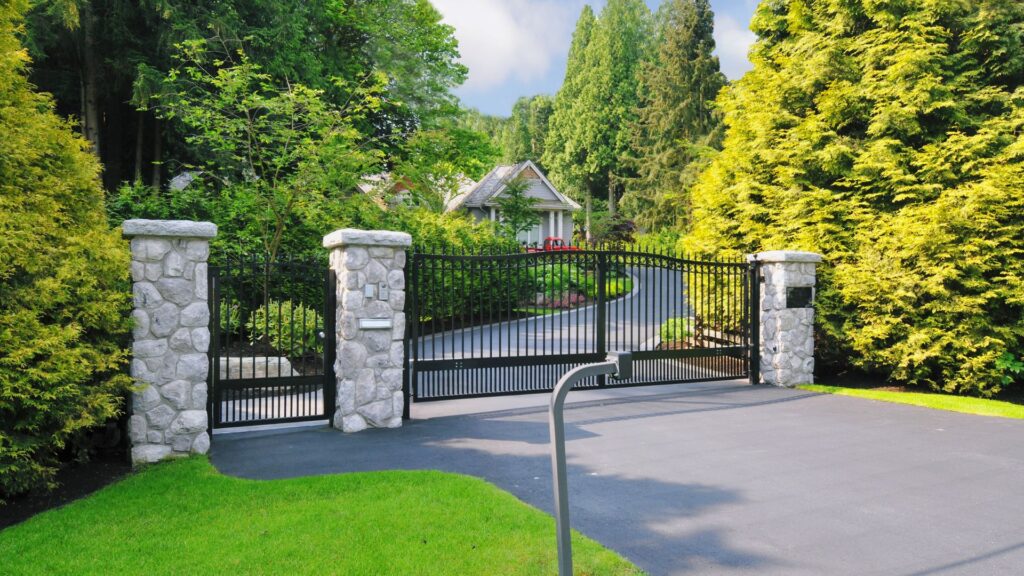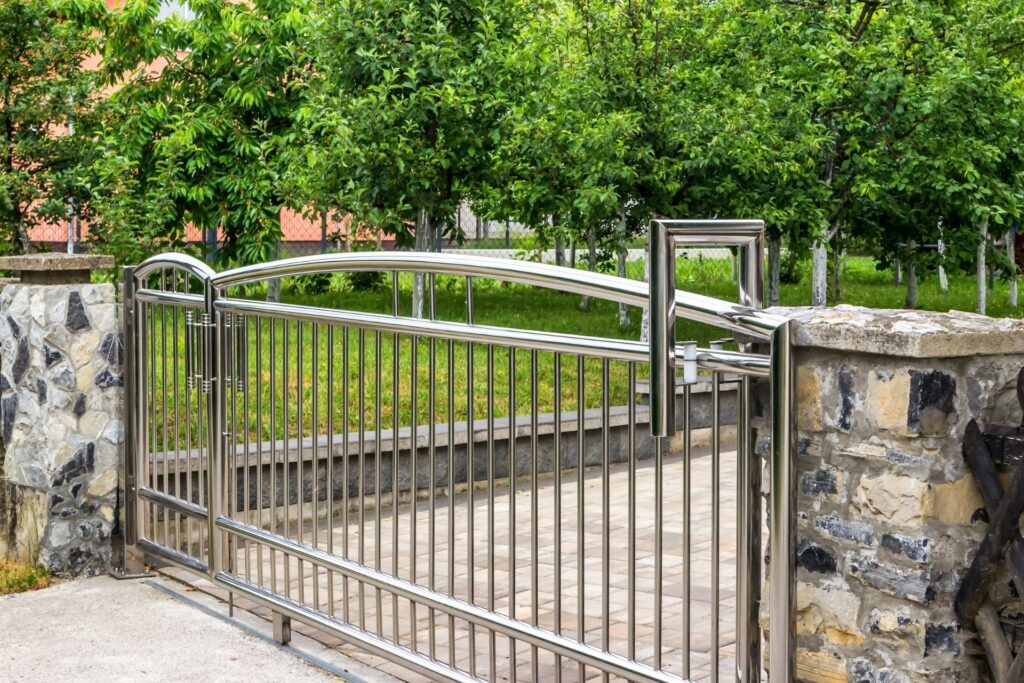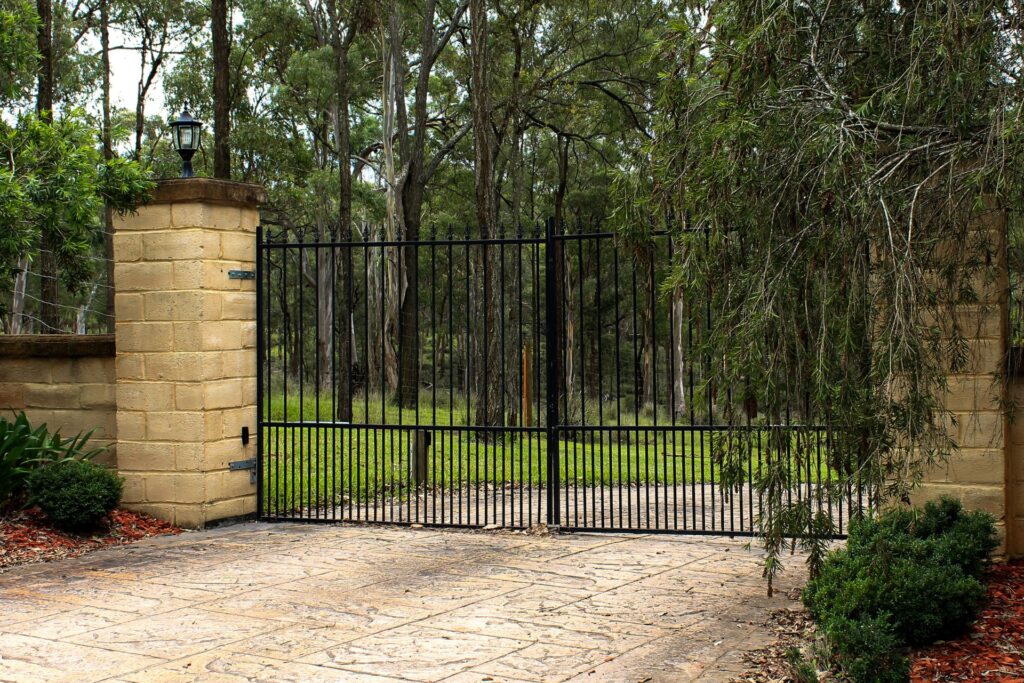Welcome to our comprehensive guide on driveway gates and the common dilemma homeowners face: should your driveway gate open in or out? If you’re considering installing a gate or simply want to make sure yours is set up for maximum safety and functionality, this decision can have a big impact. From aesthetics and space optimization to legal considerations and security, the direction your gate opens can affect your property in several ways. In this article, we’ll explore the pros and cons of both inward and outward-opening gates, helping you weigh the factors that matter most for your home and lifestyle.
The ideal direction for a driveway gate to open depends on various factors. Inward-opening gates are often preferred for maximizing security, avoiding interference with public spaces, and providing a clean aesthetic. However, outward-opening gates may be more practical on properties with steep driveways or limited internal space. Always consider property layout, safety, and local regulations when deciding whether your driveway gate should open in or out.
Table of Contents
Understanding Driveway Gate Functionality
Definition and Purpose
Driveway gates serve a variety of important purposes for property owners. At their core, they provide security by creating a barrier between the outside world and your home, helping to prevent unauthorized access. Beyond security, driveway gates also offer privacy, keeping prying eyes away from your property, and they can enhance the overall aesthetics of your home, adding a touch of elegance and style. Whether you’re looking to keep your family safe, maintain some privacy, or improve your curb appeal, a well-designed driveway gate can achieve all three.
Driveway gates operate through various mechanisms, from manually opened gates to those controlled electronically via remotes, sensors, or even smartphone apps. Depending on the design, a driveway gate can either swing open, slide to the side, or lift up, making them adaptable to different property layouts and preferences.
Factors Influencing Gate Direction
When determining which direction a driveway gate should open or close, several factors come into play. The property’s layout is critical—if you have a long, wide driveway, swing gates might be ideal. Conversely, a shorter or narrower driveway may benefit from a sliding gate. The type of gate you choose also has an impact. Swing gates are more common for properties with sufficient space for the gate to open inward or outward. However, sliding gates are perfect for areas where space is limited, such as homes with shorter driveways or awkward angles, as they neatly slide along the fence line instead of swinging open.
Swing Gates
Swing gates are the more traditional option and are often chosen for their simplicity and classic design. They function similarly to a door, swinging inward or outward on hinges. They’re typically used in situations where there is ample space for the gate to move freely without obstructing the driveway or surrounding areas. Swing gates add a stately appearance and are commonly seen on larger properties with long driveways.
Sliding Gates
Sliding gates, on the other hand, are a practical solution for properties where space is at a premium. Instead of swinging open, sliding gates glide along a track, running parallel to the fence or wall. This makes them an excellent choice for homes with narrow driveways or limited space, as they don’t require the clearance that swing gates do.
By understanding these different gate functionalities and their corresponding uses, you can choose the best type of gate for your property that meets both your practical needs and aesthetic preferences.

Pros And Cons Of Gates Opening Inwards
When deciding on the direction your driveway gate should open, choosing an inward-opening design has both benefits and drawbacks. Understanding these factors will help ensure that the gate functions well in your space while also enhancing the overall appearance and security of your property.
Advantages
Space Optimization
One of the primary advantages of inward-opening gates is their ability to optimize space. By swinging into the property rather than out onto the street or sidewalk, inward-opening gates prevent any interference with public walkways or roadways. This is particularly useful for properties located near busy streets where outward-opening gates could block pedestrian paths or cause potential hazards. By keeping the movement within the property, it also helps avoid any regulatory issues that might arise from gates encroaching on public spaces.
Aesthetic Appeal
Inward-opening gates are often preferred for their aesthetic value. The movement of the gate within the property can create a cleaner, more polished appearance from the street view, as it reduces clutter. Many homeowners appreciate that inward-opening gates contribute to a more cohesive and controlled look, as the mechanism remains hidden from passersby. This allows the design and style of the gate to enhance the visual appeal of the property without external distractions.
Security Considerations
From a security standpoint, inward-opening gates offer additional advantages. These gates can make it more difficult for unauthorized individuals to access the property from the street. Since the gate opens inward, it requires a deliberate push from inside the property, which can act as a deterrent to intruders. Furthermore, when closed, inward-opening gates provide a solid barrier that is not easily manipulated from the outside, enhancing your property’s safety.
Disadvantages
Space Limitations
However, inward-opening gates come with certain space requirements. For the gate to swing open fully, your property must have sufficient clearance, which can limit usable space within the driveway. In tight spaces, the gate’s arc could encroach on parking areas or other functional zones, making inward-opening gates less practical for smaller properties. It’s important to measure carefully to ensure that the gate’s movement won’t obstruct vehicles or other activities within the property.
Driveway Gradient Issues
Another potential drawback of inward-opening gates arises when the driveway has a slope. If your driveway slopes upward from the street toward your property, inward-opening gates may struggle to clear the ground. In such cases, the gate could drag or become obstructed by the incline, leading to mechanical issues or the need for frequent maintenance. For properties with significant elevation changes, an outward-opening gate or a sliding gate may be a more viable option.
By weighing these pros and cons, homeowners can make an informed decision that balances practicality, aesthetics, and security, ensuring that their gate serves their needs while enhancing their property’s overall appeal.

Pros And Cons Of Gates Opening Outwards
When considering the design and functionality of your driveway gate, one of the key decisions you’ll face is whether the gate should open inwards or outwards. For those leaning toward an outward-opening gate, it’s important to weigh the advantages and disadvantages to ensure the right fit for your property and lifestyle. Below, we’ll explore some of the pros and cons of this configuration.
Advantages
Maximizing Internal Space
One of the primary benefits of having a gate that opens outwards is the additional space it provides within your property. This is particularly valuable for homes with smaller driveways, where space is at a premium. By opening the gate outward, you free up the full extent of your driveway for parking or maneuvering vehicles. This can be a game-changer for compact urban properties or those with tight layouts where every square meter counts.
Easier Installation on Steep Slopes
Outward-opening gates are often a more practical solution for properties situated on steep slopes. If your driveway slopes downwards toward your property, installing an inward-opening gate might cause clearance issues, making the gate scrape against the ground. An outward-opening gate, on the other hand, avoids this problem entirely, providing a smoother and more efficient operation without requiring significant alterations to the driveway or gate design.
Disadvantages
Public Space Interference
While outward-opening gates can offer internal space-saving benefits, they may present legal and safety challenges if they interfere with public spaces. Many local councils have regulations prohibiting gates from opening into public footpaths, roads, or neighboring properties, as this can obstruct pedestrians or vehicles. If your property is adjacent to a public area, opting for an outward-opening gate could potentially expose you to fines, complaints from neighbors, or even legal liability. Therefore, it’s crucial to check local zoning laws and regulations before choosing this option.
Security Concerns
Security is another factor to consider when deciding on an outward-opening gate. Because these gates swing outward, they may be easier to tamper with from the outside. Intruders could potentially use tools to force the gate open, posing a higher security risk than inward-opening gates, which are shielded by the property itself. If security is a top priority, you may want to reinforce the gate with stronger locks or consider an alternative opening mechanism that offers greater protection against unauthorized entry.
Balancing these pros and cons will help you make an informed decision about whether an outward-opening gate is right for your property.

Local Regulations And Legal Considerations
Before installing a driveway gate, it’s essential to consider local regulations and legal requirements. Depending on where you live, your local government or homeowner association (HOA) may have specific rules in place regarding the placement and design of driveway gates. For example, in some areas, gates that swing outward onto public streets or sidewalks are prohibited to ensure the safety of pedestrians and to avoid obstructing traffic. It’s important to check with your local council or HOA to understand these regulations, as failing to comply could lead to fines or the need to redesign your gate.
- Local Laws: The rules governing driveway gates vary from one region to another, so you need to familiarize yourself with local building codes. These codes may specify that gates must open inward rather than outward, especially if your property borders a public road. Additionally, certain municipalities may require you to obtain a permit before installing a gate, particularly if it exceeds a specific height or if the gate is automated. In some cases, HOAs have stricter guidelines than local governments, particularly regarding gate aesthetics and functionality.
- Safety Requirements: Safety is a major consideration when it comes to driveway gates. Most local regulations are in place to ensure that gates do not impede emergency vehicle access, block pedestrian pathways, or create hazards for passing traffic. For example, there may be requirements for a certain amount of clearance around the gate, or mandates that automated gates have safety sensors to prevent accidents. These regulations are often designed to minimize risks to both homeowners and the public, so adherence is crucial.
- Real-Life Examples: A homeowner in Auckland recently faced a fine when their newly installed gate opened directly onto a busy sidewalk, creating a hazard for pedestrians. Despite being well-constructed, the gate had to be modified to open inward after a complaint was lodged. Another case in Christchurch involved a gate that blocked access to a neighbor’s driveway. The homeowner was required to install additional safety sensors and reposition the gate to comply with local codes. These examples highlight the importance of understanding and following regulations from the start to avoid costly mistakes and legal battles.
By thoroughly researching local laws and safety requirements before building your driveway gate, you can ensure a smoother installation process and prevent future headaches.

Safety Considerations For Both Options
When choosing between inward-opening and outward-opening driveway gates, safety is a top priority. Each option comes with distinct advantages and risks that should be carefully considered.
Inward-Opening Gates
One of the primary safety benefits of inward-opening gates is their ability to prevent accidents. Because the gate swings into your property, it minimizes the chance of striking a pedestrian or a vehicle when opening. This is particularly important in high-traffic areas or properties located near public walkways or streets. Inward-opening gates are also advantageous for vehicle and property protection. If you regularly park vehicles close to the gate, having it swing inward avoids the risk of the gate colliding with your car. Additionally, it keeps the gate well within the boundary of your property, which can reduce exposure to potential damages from external factors like passing vehicles or errant cyclists.
Outward-Opening Gates
For properties with limited driveway space, outward-opening gates may seem appealing, but they come with their own set of safety concerns. The main issue here is visibility and traffic safety. Gates that open outward can potentially obstruct the view of both drivers and pedestrians, creating dangerous blind spots. If the gate extends into a public area, it’s crucial to ensure that it doesn’t interfere with pedestrian pathways or oncoming traffic. To mitigate these risks, consider installing precautionary measures like warning signs, lights, or even reflective strips on the gate to increase visibility. These additions can serve as early alerts for anyone approaching the property, ensuring that outward-opening gates do not become a hazard to others.
By taking these safety considerations into account, you can choose a gate style that not only enhances the functionality and aesthetics of your property but also ensures the safety of everyone around it.

Environmental Factors To Consider
When building a driveway gate, it’s essential to think about the environmental factors that could influence its functionality and longevity. Your local weather conditions play a significant role in determining the most suitable design and direction of gate opening.
Weather Conditions
In areas prone to strong winds, outward-opening gates may face more strain than inward-opening ones, as the wind’s pressure can push against the gate, making it harder to open or even damaging the hinges. On the other hand, inward-opening gates might be better protected from wind force, but they may still struggle to open if snow or ice builds up along the gate’s path. For regions with harsh winters, this is a vital consideration. Snowdrifts accumulating near an inward-opening gate can block it entirely, making outward-opening gates a better option in such environments. It’s also important to think about ground clearance, ensuring there’s enough space to open the gate freely, even in icy or snowy conditions.
Maintenance Considerations
Whichever direction your gate opens, maintenance is inevitable. For outward-opening gates, hinges and other hardware are more exposed to the elements. This makes them vulnerable to rust, especially in coastal areas where salt in the air accelerates corrosion. Regular checks and treatments with rust inhibitors will be necessary. Inward-opening gates might require more effort to keep the area clear of debris, especially in autumn when leaves pile up or during winter when snow removal is a priority. In both cases, regular lubrication of moving parts and repainting or refinishing to prevent weathering are essential to prolong the life of your gate.
By factoring in these environmental and maintenance considerations, you can ensure that your driveway gate remains functional and aesthetically pleasing throughout the year.

Popular Gate Materials And Their Impact On Opening Direction
When choosing the right material for your driveway gate, the decision often comes down to more than just aesthetics. The material you select plays a crucial role in the gate’s weight, swing dynamics, and whether an inward or outward-opening design is feasible. Common materials used for driveway gates include wood, metal, and wrought iron, each with its own unique set of benefits and limitations.
Material Choices
Wooden gates offer a classic and natural look, often blending seamlessly with rural or traditional-style homes. However, wood tends to be heavier than metal options, especially if it’s thick or treated for outdoor use. This extra weight can make an outward-swinging design more difficult to manage, as it requires strong, durable hardware to support the constant pressure on hinges. Wood also expands and contracts with the weather, which can impact smooth operation over time, especially if the gate swings outward.
On the other hand, metal gates, particularly aluminum, are much lighter and provide greater flexibility in terms of swing direction. Aluminum is rust-resistant, which makes it an ideal choice for outward-swinging gates in areas with high humidity or rainfall. Wrought iron, known for its durability and ornamental appeal, tends to be heavier like wood, but its open design allows air to pass through, reducing wind resistance that could otherwise affect an outward swing.
Durability and Stability
The durability of your gate material also influences the safety and longevity of your gate. Heavy materials like wood and wrought iron tend to be more stable and less prone to movement caused by external forces, such as wind, making them better suited for inward-swinging designs. In contrast, lighter materials like aluminum may be prone to shifting, which can affect the reliability of outward-opening gates. Durability also factors into maintenance; wood needs regular sealing to avoid rot, while metal may require occasional rust-proofing depending on the type.
By considering the impact of material on both the weight and durability of your driveway gate, you can make an informed decision that ensures the safety and functionality of the gate for years to come.

Expert Opinions And Recommendations
When choosing between inward and outward-opening gates, industry experts often emphasize the importance of considering the unique layout and needs of each property. According to seasoned contractors and architects, inward-opening gates are generally preferred for residential driveways with ample space. They help avoid interference with footpaths, streets, or neighboring properties and provide a cleaner, more secure boundary for homeowners. This option also creates a more welcoming entryway, especially when the gate opens up towards a spacious driveway or garden area. On the other hand, outward-opening gates might be recommended in cases where the driveway has limited depth or slopes upward, which could hinder the gate’s inward swing. In these scenarios, architects suggest ensuring that the gate does not obstruct any public walkways or violate local regulations.
Experts strongly advise property owners to consult a professional gate installer to thoroughly evaluate the site. Not all properties are well-suited to one option over the other, and a professional can identify potential problems such as terrain difficulties, drainage issues, and safety concerns. By working closely with an expert, property owners can be assured that their gate choice will meet functional requirements while enhancing curb appeal. Whether it’s selecting the best material, ensuring proper automation mechanisms, or making sure the gate complies with local codes, the guidance of an experienced installer is invaluable in achieving a seamless and successful gate installation.
This expert-driven advice ensures that the gate is not just aesthetically pleasing but also long-lasting and legally compliant.

FAQs: About Should Driveway Gates Open In Or Out
What are the main factors to consider when choosing the direction for a driveway gate?
When deciding whether your driveway gate should open in or out, key factors include the layout of your property, the amount of available space, local regulations, and the type of gate (swing or sliding). Other considerations include the slope of your driveway, security preferences, and how the gate will interact with public areas like sidewalks and roads.
Are inward-opening gates more secure than outward-opening gates?
In many cases, inward-opening gates are considered more secure because they reduce the risk of unauthorized access from the outside. Since the gate swings into the property, it’s harder for outsiders to tamper with the gate from the street, offering an added layer of protection.
Can outward-opening gates be installed on any property?
Outward-opening gates can be installed, but they may not be allowed in areas where they could interfere with public sidewalks, streets, or neighboring properties. Always check local regulations before opting for an outward-opening gate to ensure compliance and avoid legal issues.
How does the slope of my driveway affect gate direction?
The slope of your driveway plays a significant role in determining gate direction. For example, if your driveway slopes upward from the gate, an inward-opening gate might be difficult or impossible to install. Conversely, if the driveway slopes downward, an outward-opening gate might be more practical.
Are there any legal restrictions on whether a driveway gate can open outwards?
Yes, many local authorities have regulations that prohibit driveway gates from opening outward into public spaces like sidewalks or roads. Violating these regulations can result in fines or orders to modify the gate. Always consult your local building codes before deciding on gate direction.
What are the advantages of inward-opening gates?
Inward-opening gates offer several advantages, including improved security, reduced risk of interfering with pedestrians or vehicles, and a cleaner aesthetic that keeps the gate’s movement within your property. These gates also prevent your gate from blocking public areas when open.
What are the disadvantages of inward-opening gates?
The primary disadvantages of inward-opening gates are that they require sufficient space within your property to swing open, potentially reducing usable driveway space. Additionally, if your driveway slopes upwards, inward-opening gates may not function properly.
Why might someone choose an outward-opening gate?
Outward-opening gates are often chosen when the property has limited internal space, or the driveway slopes upwards, making inward-opening gates impractical. They also allow more room within the driveway for parking or maneuvering vehicles.
What materials are best suited for driveway gates, and do they affect the opening direction?
Common materials for driveway gates include wood, metal, and wrought iron. Heavier materials like metal and iron may require stronger hinges and motors for automated gates, which could influence whether an inward or outward opening is more suitable, depending on your driveway’s layout and space.
Should I consult a professional before deciding on the direction of my driveway gate?
Yes, it’s always recommended to consult a gate installation professional. They can assess your property, take into account all factors like space, slope, local regulations, and gate type, and help you make the best decision regarding the direction your gate should open.
Conclusion
In conclusion, both inward and outward-opening gates have distinct advantages and disadvantages, depending on your property’s layout and your individual needs. Inward-opening gates are often preferred for their ability to maximize street space and comply with local regulations, while outward-opening gates can be beneficial when driveway space is limited. Ultimately, the best option will depend on factors like your property’s dimensions, terrain, and any applicable building codes in your area. It’s important to carefully weigh these considerations and align them with your personal preferences before making a decision. For tailored guidance and professional input, we highly recommend reaching out to gate installation experts or contractors who can provide customized solutions that suit your specific situation.
About the Author:
Mike Veail is a recognized digital marketing expert with over 6 years of experience in helping tradespeople and small businesses thrive online. A former quantity surveyor, Mike combines deep industry knowledge with hands-on expertise in SEO and Google Ads. His marketing strategies are tailored to the specific needs of the trades sector, helping businesses increase visibility and generate more leads through proven, ethical methods.
Mike has successfully partnered with numerous companies, establishing a track record of delivering measurable results. His work has been featured across various platforms that showcase his expertise in lead generation and online marketing for the trades sector.
Learn more about Mike's experience and services at https://theleadguy.online or follow him on social media:








